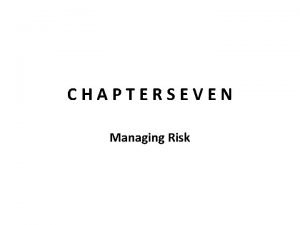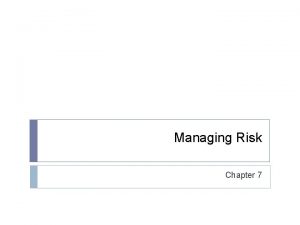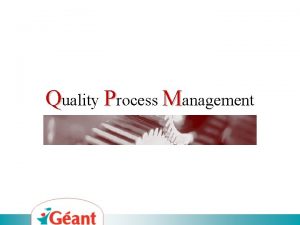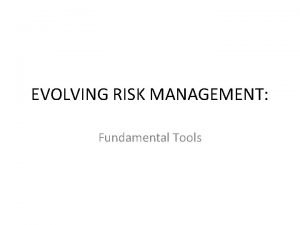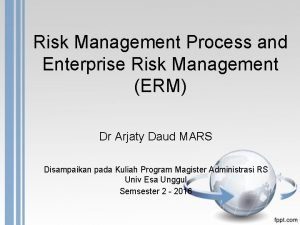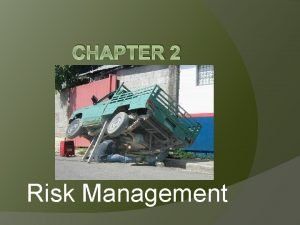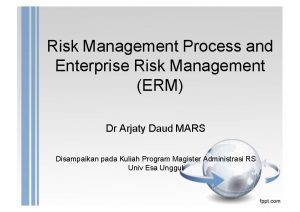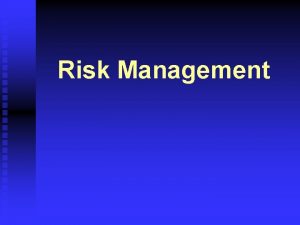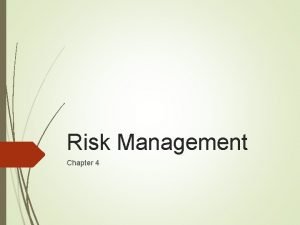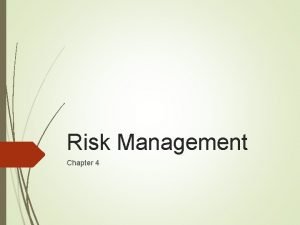RISK MANAGEMENT PURPOSE Risk Management is the process




































- Slides: 36

RISK MANAGEMENT

PURPOSE: Risk Management is the process of making and carrying out our decisions that will minimize the adverse effects of accidental losses to the organization

PURPOSE Risk Management will strive to reduce both the frequency and severity of losses to the organization via risk control and risk financing techniques. All staff participates in risk management activities in their day-to-day operations

PURPOSE The purpose of Risk Management is to prevent injury and to prevent or limit financial loss to the institution. Commitment, cooperation, and support from the Governing Board, Administration, Department Heads and all staff and associates are key to any successful Risk Management Program

POLICY Maintain and improve the hospital and clinic's functions, departments, and Medical Leadership, quality patient care, at the least possible risk, at the lowest possible cost.

POLICY Minimize the probability of events which have adverse physical and/or psychological effects on patients, visitors, and staff; or result in physical losses to the facility and equipment

POLICY Minimize expenditures by the hospital system to insure against the occurrence of such events

POLICY Minimize compensation paid and associated legal and administrative costs when such events result in injury, death, or damage.

GOALS Evaluate the identifies or potential loss to the organization through risk management reporting mechanisms, trend analysis and frequency and severity data; determine the loss effect; monitor for proper implementation and effectiveness, and review for the need for continued monitoring, change or addition of loss control actions, and final resolution of the problem.

GOALS Provide an integration of the risk related information and activities through the programs of Infection Control, Employee Health and Safety.

GOALS Report findings of risk management issues, trends, actions, and follow-up to appropriate departments, Administration, Medical Staff and Board.

GOALS Monitor the efficiency of program and education developed and implemented to reduce risk and patient/visitor/volunteer injury

STRUCTURE Risk Management will be responsible, interface with, the following hospital and clinic areas: Patient Incident and Employee Accident Reporting; Safety Program; Disaster Management and Preparedness; Employee Health and Work Place Hazards; Infection Control; Pharmacy and Therapeutics; Medical Staff; Credentialing and Committees; Administration; Employee Education; and Business Office (Claims Administration).

RESPONSIBILITY The Board of Trustees has the final authority and responsibility for assuring that mechanisms are in place for reducing exposure to risk and that these mechanisms are effective and under continuous review. The Board of Trustees delegates to the Medical Staff and the Administrator the authority to identify and correct risk related uses that represent actual or potential sources of injury and safety concerns affecting all users of the Mc. Kenzie County Healthcare Systems.

RESPONSIBILITY The responsibility to evaluate, recommend corrective action and follow-up for risk situations has been assigned by the Administrator to the Risk Manager. The Risk Manager is assigned the responsibility to provide leadership and coordination in developing and implementing strategies for the program. The Risk Manager communicates with, and obtains input from the Quality Improvement Coordinator, Safety Coordinator, and Administration. The manager reports to the Medical Staff, Administration and the Board of Trustees monthly through the Quality Improvement Program.

COMMITTEE Works closely with Quality Improvement Committee. Same members.

MANAGER PAULA BROWN IS THE RISK MANAGER

PLANT SAFETY AND TECHNOLOGY The Safety Committee and in concert with Infection Control, Human Resources (Administration), Environmental Services, and the Risk Manager will work together to facilitate a comprehensive Safety Management Program that is designed to provide a physical environment free of hazards and to monitor employee and patient activities to reduce the risk of human injury. Appropriate staff participation is encouraged.

SPECIFIC POLICIES • INFECTION CONTROL MANUAL • SAFETY/EMERGENCY MANUAL, DIASASTER MANUAL

Medical errors • WHAT ARE MEDICAL ERRORS? • Medical errors happen when something that was planned as a part of medical care doesn't work out, or when the wrong plan was used in the first place. Medical errors can occur anywhere in the health care system: • Hospitals. Clinics. • Outpatient Surgery Centers. Doctors' Offices. • Nursing Homes. Pharmacies. • Patients' Homes.

INFORMATION • Is Risk Management Only About Safety? Answer: NO • Is Risk Management Only Responsibility of Top Management? Answer: NO

TYPES OF ERRORS

TYPES OF RISKS • • • 1. 2. 3. 4. 5. 6. Facility and Safety Risk Operational Risk Occupational Health risk Financial Risk Communication Risk Security Risk

EXAMPLES OF RISKS • • • Nosocomial Infections Communications Failure High Occupancy Wrong Identification of Patient Chemical/Radiation Exposure

RISK MANAGEMENT APPLICATION OF RISK MANAGEMENT TOOLS AND STRATEGIES IN HOSPITAL 1. 2. 3. 4. 5. Meetings / Committee Reports OVRs (occurrence/variance report) HAZARD Surveillance Hazard Vulnerability Analysis Risk Analysis Form

OTHER ISSUES • • • Patient Service Risk Assessment Equipment obsolescence Repeat calls for same problem Loss of phones Loss of computers Patient has a long wait Patient can’t get through Patient can’t get answers Fraud Lost transactions Employee morale

LITIGATION • The Perception of Risk • Not always about money • Encourage discourse between legal and medical professions

Scope of Patient Safety Program Non-Punitive Reporting System • MCKENZIE COUNTY HEALTHCARE SYSTEMS Hospital recognizes that if we are to succeed in creating a safe environment for the patients, we must create a non-punitive environment in which caregivers can report and learn from errors (variances/occurrences). The hospital promotes openness and requires mistakes be reported, while ensuring that reported mistakes will be handled fairly and objectively. • The hospital recognizes that most clinical variances are due to a failure of systems or processes. The goal is to identify and track occurrences in order to continuously improve the system/processes. • Definition: • Variance - any occurrence out of the ordinary including medication variances which may involve risk (near miss) or actual injury to an individual or damage to hospital property • Near Miss - any process variation that did not affect an outcome but for which a recurrence carries a significant chance of a serious adverse outcome.

Variance/Near Miss Reports • A Variance (Incident/Accident) /Near Miss report should be completed for any occurrence out of the ordinary, which may involve risk (near miss) or actual injury to an individual or damage to hospital property. Any individual is defined as patient, employee, volunteer, student, physician or visitor. All variances must be reported immediately to the supervisor. Supervisor will conduct the immediate investigation/follow-up/corrective action. Variance reports should be completed and forwarded to the Quality Improvement Department as soon as possible, but no later than 72 hours from discovery. Variances of a significant nature need to be communicated in a timely manner to Administration and the QI Department.

Root Cause Analysis • MCKENZIE COUNTY HEALTHCARE SYSTEMS Hospitals is dedicated to trying to understand how and why a sentinel event, unusual occurrence, or risk thereof*, occurred and how to prevent the same or similar event from occurring in the future *"Or risk thereof" - this phrase includes any process variation for which a recurrence would carry a significant chance of a serious adverse outcome.

Sentinel Event An unfortunate, but occasional serious adverse event involving a patient must be quickly and comprehensively investigated, evaluated, and analyzed so as to identify every possible modification or change in patient care delivery systems which might prevent similar adverse events in the future. Refer to the Sentinel event Policy in the Nursing III policy and procedure manual. • At the time of a sentinel event staff will perform any necessary clinical interventions to support and protect the patient and notify the physician responsible for the patient, carrying out any necessary physician orders.

INCIDENT REPORTS ALL INCIDENTS/NEAR MISSES ARE REPORTED THROUGH THE HEALTHCARE SAFETY ZONE PORTAL (HSZP) ON-LINE. HOSPITAL/CLINIC/WELLNESS CENTER- STAFF CAN DO THE REPORTING ON THE COMPUTER – MANAGERS HAVE THE LINK TO HSZP OR IN SOME CASES THE LINK IS SET UP ON THE COMPUTER. GSH – NEED TO COMPLETE A PAPER FORM AND GIVE TO THE DON OR TO MEL JOHNSON TO ENTER INTO THE SYSTEM

REPORTING SAFETY ISSUES STAFF CAN REPORT A SAFETY ISSUE BY • CONTACTING THEIR SUPERVISOR • FILING AN ON-LINE REPORT THROUGH THE HEALTHCARE SAFETY ZONE PORTAL • FILING A PAPER FORM

SAFETY PROGRAM POLICY: A principal part of the healthcare system’s objective of providing the best in quality patient care is the administration of an efficient and effective safety program. This may be achieved by providing a safe working environment and assuring that both management and employees are aware of their responsibilities regarding accident prevention. It shall be the policy of the healthcare system to continually develop, promote and enforce safe work practices and provide a hazard-free working environment consistent with national consensus standards or established federal, state and local regulations. The healthcare system will actively participate in a Risk Management Program

SAFETY POLICIES SAFETY PROGRAM POLICY AND PATIENT SAFETY PLAN ARE IN THE SAFETY/EMERGENCY MANUAL THAT IS IN EVERY DEPARTMENT.

Employees • Employees are responsible to know and follow all safety rules and procedures in safety program development and implementation. • All employees are responsible for attending all management-mandated safety training programs and to support the accident prevention program established by management.
 Market risk credit risk operational risk
Market risk credit risk operational risk Fiduciary investment risk management association
Fiduciary investment risk management association Risk map risk management
Risk map risk management Hình ảnh bộ gõ cơ thể búng tay
Hình ảnh bộ gõ cơ thể búng tay Frameset trong html5
Frameset trong html5 Bổ thể
Bổ thể Tỉ lệ cơ thể trẻ em
Tỉ lệ cơ thể trẻ em Gấu đi như thế nào
Gấu đi như thế nào Tư thế worm breton
Tư thế worm breton Alleluia hat len nguoi oi
Alleluia hat len nguoi oi Môn thể thao bắt đầu bằng từ chạy
Môn thể thao bắt đầu bằng từ chạy Thế nào là hệ số cao nhất
Thế nào là hệ số cao nhất Các châu lục và đại dương trên thế giới
Các châu lục và đại dương trên thế giới Cong thức tính động năng
Cong thức tính động năng Trời xanh đây là của chúng ta thể thơ
Trời xanh đây là của chúng ta thể thơ Mật thư tọa độ 5x5
Mật thư tọa độ 5x5 101012 bằng
101012 bằng Phản ứng thế ankan
Phản ứng thế ankan Các châu lục và đại dương trên thế giới
Các châu lục và đại dương trên thế giới Thơ thất ngôn tứ tuyệt đường luật
Thơ thất ngôn tứ tuyệt đường luật Quá trình desamine hóa có thể tạo ra
Quá trình desamine hóa có thể tạo ra Một số thể thơ truyền thống
Một số thể thơ truyền thống Cái miệng nó xinh thế
Cái miệng nó xinh thế Vẽ hình chiếu vuông góc của vật thể sau
Vẽ hình chiếu vuông góc của vật thể sau Nguyên nhân của sự mỏi cơ sinh 8
Nguyên nhân của sự mỏi cơ sinh 8 đặc điểm cơ thể của người tối cổ
đặc điểm cơ thể của người tối cổ V cc cc
V cc cc Vẽ hình chiếu đứng bằng cạnh của vật thể
Vẽ hình chiếu đứng bằng cạnh của vật thể Phối cảnh
Phối cảnh Thẻ vin
Thẻ vin đại từ thay thế
đại từ thay thế điện thế nghỉ
điện thế nghỉ Tư thế ngồi viết
Tư thế ngồi viết Diễn thế sinh thái là
Diễn thế sinh thái là Các loại đột biến cấu trúc nhiễm sắc thể
Các loại đột biến cấu trúc nhiễm sắc thể Bảng số nguyên tố lớn hơn 1000
Bảng số nguyên tố lớn hơn 1000 Tư thế ngồi viết
Tư thế ngồi viết












































